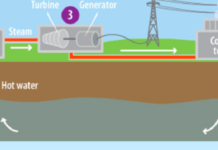The I-64 project status sign, located on the I-170 approach to Brentwood, Missouri, has been counting down the months and days until project completion since early January of 2008. 
Two sections of the roadway have been alternately closed to traffic forcing motorists to seek other routes. According to Dan Galvin of Gateway Constructors, the complete closures have been necessary because of the deteriorating condition of the roadway and the 30 bridges along the route, many of which had to be demolished and replaced. “When a bridge is new it is rated a 9, and by the time the condition deteriorates to the point where it is rated a 2 you have to close it for safety. Of the 30 bridges on the project, half were rated a 3 or a 4.” Galvin compared the bridges along the I-64 corridor to the I-35 bridge in Minneapolis that collapsed in August of 2007 taking thirteen lives. The I-35 bridge was rated a 4.
Had I-64 remained partially open during bridge and roadway reconstruction, the project would have taken an additional 4 years, resulting in more cost to taxpayers and increased risk of injury to workers. Gateway Constructors has led a consortium of contractors working on the I-64 project.
Cathie Farroll, a MoDOT spokesperson for the I-64 project, says that the overall quality of the finished roadway will be enhanced by the complete closures. “By closing the highway in sections, crews are able to produce higher quality pavements and stronger, more durable bridges. Entire bridge decks can be poured at one time, and 24 feet wide sections of pavement are more durable, as well.” Farroll adds that the resulting higher quality translates into reduced maintenance costs and a longer life cycle for the pavement and bridges.
Generally, motorists on Interstate highways experience lane closures as repairs are carried out on a lane by lane basis, in most cases using asphalt as a new top layer for the road surface. However, the I-64 project was not suited for this piecemeal approach. The original roadway was constructed during the 1930s and 1940s as part of the old US 40, predating the construction of the Interstate Highway System. Adapting the antiquated roadway to 21st century Interstate standards mandated a complete rework for much of the roadway from top to bottom.
Although the concrete road surface of I-64 will appear new, 130,000 tons of old concrete and asphalt from the remains of the former highway and bridges are being reused for paving. According to some industry studies, concrete is more durable and can last twice as long as asphalt while costing only slightly more. In a 2007 University of Michigan study, records indicated that significant maintenance on concrete roadways were not required for almost 20 years after construction versus 10 years for asphalt.
Accordingly, motorists on the new I-64 roadway should not be detoured again until 2030.














The information about the bridges was frightening. It is a good thing they decided to redo them. The decision may have saved lives. I am glad they chose to close the interstate completely so that they could build a better interstate in the long run. It was well worth the wait.
I like this article. I had no idea about the bridge and that they were considering to not close down the interstate completely. I think it was a smart move. I also can’t wait to drive on it! Good article. :smile